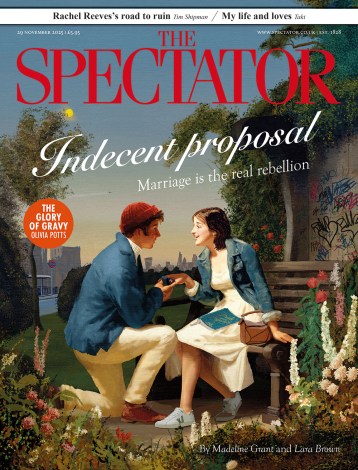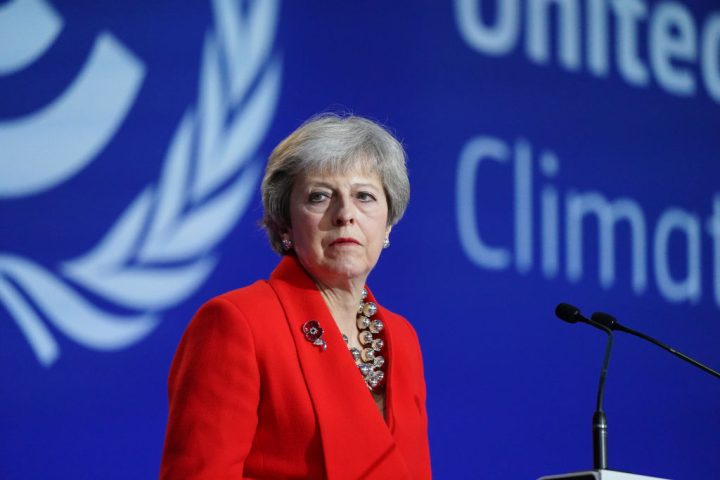The blond bombshell has criticised Sunak’s new Windsor Framework as not passing the Brexit test of taking back control. He’s made clear that he believes abandoning the Northern Ireland Protocol Bill is a terrible idea and says he will find it very hard to vote for his successor’s measure.
In return, Sunak loyalists are muttering about it being Johnson’s mess – i.e. the original disastrous protocol that he agreed and then oversold at the tail end of 2019 – that their man has been clearing up.
In fact, they both have good reason to feel chippy – but not with each other. For the true villain of the piece has altogether escaped accountability. That villain is The Leaning Tower of Theresa, the woman who so theatrically tilted into a horizontal position in her seat in the Commons this week when Sir Bill Cash dared to mention the Maastricht Treaty.
Given the poisonous legacy they inherited from her, both Johnson’s team and then Sunak’s have made broadly the right choices
Mrs May’s handling of the early stages of Brexit negotiations set in motion a chain of events that was destined to lead either to the whole UK not Brexiting properly or to Northern Ireland alone not Brexiting properly. Given the poisonous legacy they inherited from her, both Johnson’s team and then Sunak’s have made broadly the right choices and done well to advance matters, in two stages, to where they are now.
Her capitulation to Brussels too came in two stages. First, she agreed to the EU’s demand for the ‘sequencing’ of Brexit talks, by which it meant sorting out the issues that concerned it first before turning to the things on our wish list. So our divorce payment, the rights of EU citizens living in the UK and the position of Northern Ireland had to be settled before the talks could move on to issues such as our future trading access into the EU market. By agreeing such an order of events and thereby abandoning the usual rule in complex talks that ‘nothing is agreed until everything is agreed’, Mrs May surrendered significant British leverage.
Much worse was to follow. In December 2017, the two sides published a joint report on the progress they had made on these early ‘phase one’ issues.
On the issue of Northern Ireland it was a disaster. Either through incompetence or sheer Remainer deviousness, Mrs May accepted two distinct duties on behalf of the United Kingdom which in combination torpedoed hopes of our country as a whole ‘taking back control’. The first was set out in paragraph 43: ‘The United Kingdom also recalls its commitment to the avoidance of a hard border, including any physical infrastructure or related checks and controls.’ The second was set out in paragraph 45: ‘The United Kingdom respects Ireland’s ongoing membership of the European Union and all of the corresponding rights and obligations that entails, in particular Ireland’s place in the internal market and customs union.’
May didn’t tell the EU that the UK wouldn’t place physical border controls on the island of Ireland or hope that it would make the same undertaking and work to find a joint light-touch solution to protecting the integrity of internal markets. Instead, by not doing so, she rendered it a British responsibility to find a solution.
Not only would we not create a hard border, but we would also have to come up with something that meant the EU and the Republic of Ireland did not feel it necessary for them to create a hard border, while still being able to protect their own single market frontier.
The only way this could be done was to rope the whole UK into continued trading lockstep with the EU– the ‘Common Rule Book’ approach that reared its head in the notorious Chequers deal that May sprang on her cabinet. Alternatively, the answer would be to keep Northern Ireland in the EU single market and impose a border between it and Great Britain in the Irish Sea.
When Johnson took over, after Mrs May had failed to deliver any kind of Brexit whatsoever and with the Benn Amendment forbidding him from leaving the EU without a deal, he held his nose and went for the second option. As Lord Frost, former Brexit negotiator, told me when I bumped into him last week: ‘We wouldn’t have started from there.’
Johnson always envisaged returning to the issue post-Brexit and achieving something that anchored Northern Ireland in the rest of the UK market more securely. That is what prompted him to launch the Northern Ireland Protocol Bill, which would have bestowed upon the UK government powers to walk away from onerous protocol provisions unilaterally.
For his part, Sunak has acknowledged the role this piece of proposed legislation played in concentrating minds at the European Commission upon the need for an alternative way forward. Sunak’s Windsor Framework did not amount to a Unionist purist solution, but it did represent an advance on the original protocol, as even Johnson has appeared to concede.
Had the UK government negotiated in a coherent and tough manner from the outset then worries about a land border with a UK that had left the EU would have represented a major weakness in the Brussels position. This would have made reaching a comprehensive deal in which all matters were settled simultaneously a high priority.
In the event, Mrs May allowed the Brussels team to pocket a game, set and match of wins at the outset and then pile pressure on the UK by adopting the mantra ‘the clock is ticking’ as its catchphrase. She was a disaster. On this matter, Messrs Johnson and Sunak should accord each other some respect and some latitude too.
Were Johnson to set aside his obvious bitterness at being supplanted by Sunak, he would see that his successor’s far-from-ideal deal deserves to be supported.







Comments